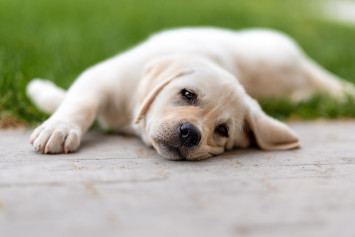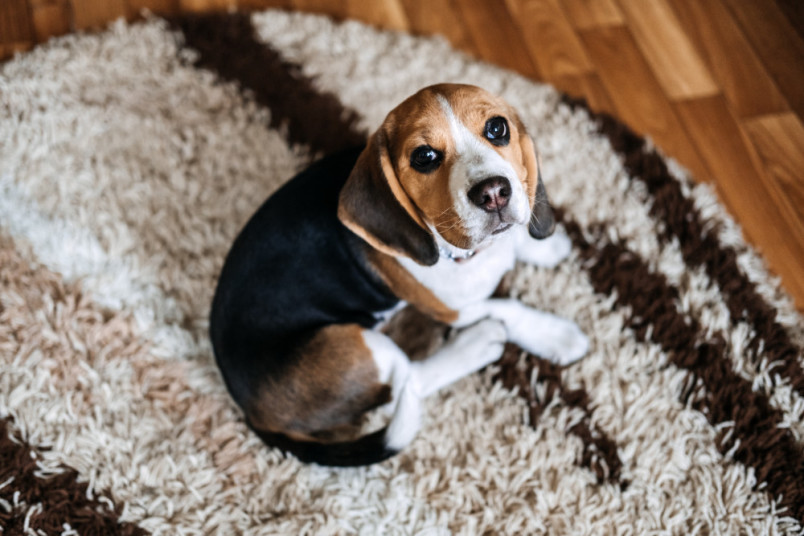
There are certain issues pet owners prepare for when bringing a puppy home, such as chewed shoes, fleas, and perpetually hungry bellies. One problem they may not be ready for is parvo. Parvo, the nickname for canine parvovirus, is a contagious viral disease that’s most common in young dogs, although it occasionally affects older dogs.
Parvo in puppies can be fatal. The mortality rate for untreated dogs is as high as 91%. While these numbers can be frightening, treatment is available. That’s why it’s essential for pet owners to learn how to identify the disease’s signs. This way, their young dogs can receive prompt treatment if infected.
The great news is that infected dogs who are treated have a survival rate of up to 92%, although hospitalization costs can amount to $10,000 in severe cases. The better news is that there’s a parvo vaccine available that’s affordable and convenient. Read on to learn more about parvo and how you can make sure your new furry bundle of joy stays safe and healthy.
Causes and Transmission of Parvo
There are several strains of canine parvovirus type 2 (CPV-2). The virus causes issues by targeting the gastrointestinal tract and heart muscles.
How do puppies get parvo? The disease spreads in many ways. Dogs can get it from being around infected dogs, such as their littermates or a neighbor’s pet. They can also get it by encountering a sick dog’s feces, which often happens at dog parks or apartment complexes. Puppies can contract parvovirus indirectly from objects (blankets, toys, beds, etc.) that have been around sick dogs as well. This means that transmission can occur through shared food and water bowls, kennels, or even your unwashed hands or clothes.
Puppies are most likely to contract parvo from ages six weeks to six months. Certain breeds, including German Shepherds and Doberman Pinschers, are more likely to become infected. No matter which breed of dog your puppy is, it’s best to keep them away from other canines until they’ve had their full set of vaccinations.
One study found out that dogs who survive a parvo infection are more likely to develop chronic gastrointestinal disease later in life. This is yet another reason pet owners should take precautions against their puppies getting parvo.
Signs of Parvo in Puppies
Some signs of parvo are similar to those of other conditions like heartworm in puppies or Lyme disease. Only a vet can make a definitive parvo diagnosis. Signs of parvo in a puppy typically include the following:
Lethargy: Puppies are known for being highly active. If your dog doesn’t seem to be bouncing around like he normally does, they may not be feeling well. Lethargic dogs are slow moving and may spend much of the day sleeping.
Loss of appetite: Because parvo affects the gastrointestinal tract, dogs with this disease aren’t interested in eating as much as normal. They may turn away from food or take only a few bites.
Change in body temperature: A dog’s temperature is typically between 101.0 to 102.5°F. Dogs with parvo may exhibit fevers or even a lower-than-normal body temperature, which means you’ll need to keep an eye on your pup’s temperature. You can take their temperature with a special dog thermometer that can be inserted into the ear canal or the rectum.
Diarrhea and vomiting: It’s not uncommon for young dogs to vomit occasionally as they may eat too quickly or eat something they shouldn’t have. However, repeated vomiting, especially with other signs like not eating or diarrhea could indicate parvo.
Diarrhea with blood: Dogs infected with parvo often have bright red blood in their stool. The diarrhea often has a terrible foul odor that is a tell-tale sign of parvo.

No pet parent wants to see their puppy in pain. Keep in mind that if your dog displays one or more of these symptoms, it doesn’t automatically mean they have parvo. Many times, your puppy may have a mild cold that’s no cause for concern. The only way to know for sure is to schedule a vet appointment as soon as possible.
Diagnosis and Treatment of Parvo
A veterinarian will evaluate your puppy for signs of parvo. To rule out other diseases, the vet will need to examine a stool sample from your dog or draw blood to check for signs of the virus. Stool samples are the most common way for dogs to be diagnosed. Abdominal X-rays may be needed to give veterinarians more insight into what is causing the issue.
Once your vet has made a positive diagnosis, they may prescribe certain medications to help support your pup and treat their signs. This may include anti-nausea medicine or antibiotics.
Your vet may recommend other treatments besides medicine. Puppies with parvo are susceptible to dehydration. If your dog has lost significant fluids due to diarrhea and vomiting, your vet may give them an intravenous drip (IV). An IV will replenish their nutrients and fluids to help your dog feel better. A puppy with an especially low blood count may also need a blood transfusion to help increase those numbers.
Dogs with mild parvo infections may be sent home the same day to recover. In this case, your puppy will need to be isolated from other dogs while they are recovering. This isolation period helps prevent the spread of the disease while also ensuring your dog gets the rest they need.
If your dog’s parvo infection is severe, they may need to remain in a veterinary hospital. In these cases, your pup will receive more intensive care and constant monitoring.
Prevention of Parvo Starts with Vaccination
Vaccination is a must for puppies. They’re more at risk for the disease, including a variant that causes heart inflammation. Even if your dog is older, they should still be vaccinated against parvo since there’s a chance they could become infected and then spread the illness to unvaccinated dogs.
Typically, puppies must be at least six weeks old before they get their first shot in the parvo vaccination series. Referred to as the DAPP vaccine, this shot not only helps protect puppies from canine parvovirus but also distemper, adenovirus-2, and parainfluenza. After completing their first DAPP series, your dog will need to get the DAPP vaccine every one to three years.
The puppy shots’ cost depends on your location and the clinic that administers the series. However, you can expect to pay approximately $35-$40 for your dog’s DAPP shots. This cost is extremely affordable considering the high cost of hospitalization stay if your puppy contracts parvovirus.

How can you protect a puppy who is too young for shots? Keep them away from other dogs until they’re fully vaccinated. Use the time to train your pup so they learn to come when called. This way, you can teach them to stay away from potentially contaminated objects you might come across on your walks.
One of the best ways to invest in your dog’s health is by buying them puppy insurance. No one wants to have to turn down lifesaving medical interventions because of money problems. Having insurance and a supplemental wellness plan helps pet owners prepare for those unexpected veterinary costs.
Unfortunately, no vaccine is 100% effective. It’s worth noting that even if your dog is up to date on their vaccines, there’s still a small chance they could get parvo. Insurance can potentially save a pet owner thousands of dollars in this case, depending on the severity of the disease.
Keep Your Puppy Safe from Parvo
There are many measures you can take to lessen the chance of your beloved puppy getting sick from canine parvovirus. The most effective prevention is vaccination. Keeping your dog up to date on their DAPP shots can mean the difference between life and death.
Even if your dog is vaccinated, keep an eye out for any unusual signs like vomiting and diarrhea as these can be related to parvo. While your dog is undergoing their first round of shots, keep them isolated from other dogs.
Insurance and wellness plans are convenient ways to stay on top of current and future medical expenses. Take steps to ensure your furry friend’s health now so they can spend their future days playing worry-free!